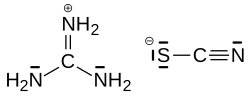Guanidinium thiocyanate
| Structural formula | |||||||||||||||||||
|---|---|---|---|---|---|---|---|---|---|---|---|---|---|---|---|---|---|---|---|

|
|||||||||||||||||||
| General | |||||||||||||||||||
| Surname | Guanidinium thiocyanate | ||||||||||||||||||
| other names |
|
||||||||||||||||||
| Molecular formula | C 2 H 6 N 4 S | ||||||||||||||||||
| Brief description |
white, odorless solid |
||||||||||||||||||
| External identifiers / databases | |||||||||||||||||||
|
|||||||||||||||||||
| properties | |||||||||||||||||||
| Molar mass | 118.16 g mol −1 | ||||||||||||||||||
| Physical state |
firmly |
||||||||||||||||||
| density |
1.29 g cm −3 |
||||||||||||||||||
| Melting point |
118 ° C |
||||||||||||||||||
| boiling point |
Decomposition: from 115 ° C |
||||||||||||||||||
| solubility |
very good in water (1420 g l −1 at 20 ° C) |
||||||||||||||||||
| safety instructions | |||||||||||||||||||
|
|||||||||||||||||||
| As far as possible and customary, SI units are used. Unless otherwise noted, the data given apply to standard conditions . | |||||||||||||||||||
Guanidinium thiocyanate , also known as guanidine thiocyanate , is the thiocyanate salt of guanidine .
use
As a chaotrope it is used to denature proteins.
It is used in the inactivation of viruses . Guanidinium thiocyanate is also used to lyse cells and virions and for DNA and RNA isolation . A widely used method is guanidinium thiocyanate-phenol-chloroform extraction .
Individual evidence
- ↑ a b c d e f g guanidinium thiocyanate data sheet (PDF) from Merck , accessed on April 3, 2011.
- ↑ Chomczynski, P. & Sacchi, N. (1987): Single-step method of RNA isolation by acid guanidinium thiocyanate-phenol-chloroform extraction. ( Memento from February 15, 2010 in the Internet Archive ) In: Anal. Biochem. 162 (1): 156-159. PMID 2440339
- ↑ Chomczynski, P. & Sacchi, N. (2006): The single-step method of RNA isolation by acid guanidinium thiocyanate-phenol-chloroform extraction: twenty-something years on. (PDF; 126 kB) In: Nat. Protoc. 1 (2): 581-585. PMID 17406285
- ↑ Classic Protocols (2006): Purification of RNA from cells and tissues by acid phenol-guanidinium thiocyanate-chloroform extraction. (PDF; 67 kB) In: Nat. Methods. 3 (2): 149.
